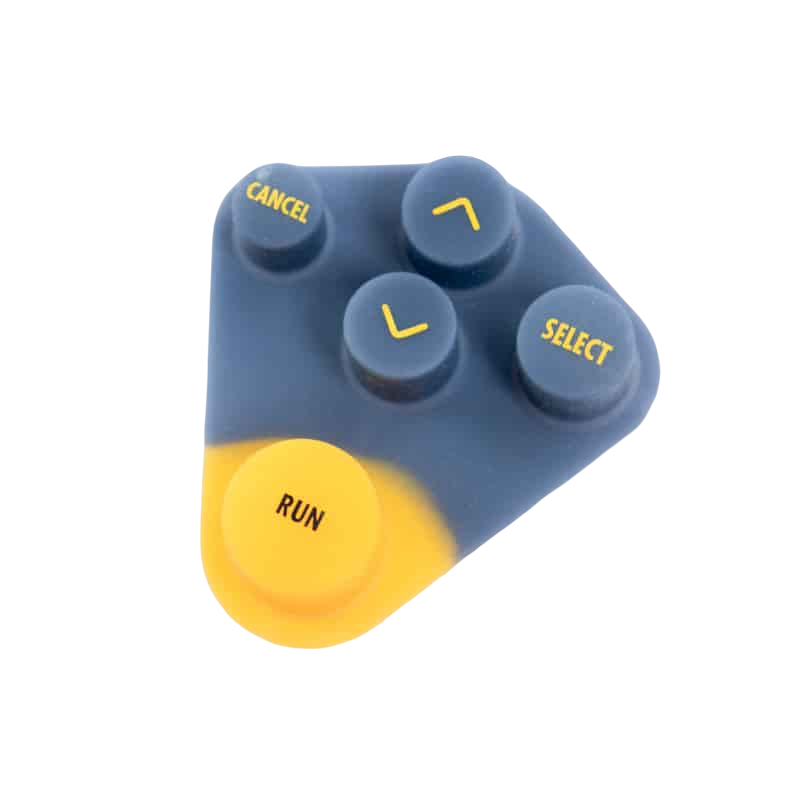Conductive Rubber Keypad: A Versatile Solution for User Interfaces
Structure and Functionality of Conductive Rubber Keypads
Conductive rubber keypads are composed of a base made from silicone rubber, infused with conductive particles such as carbon or metal. This base is molded to create a precise and ergonomic shape, featuring individual buttons or keys. The conductive particles allow for electrical conductivity when pressure is applied to the keypad.
When a user presses a key on the conductive rubber keypad, the compression of the rubber causes the conductive particles to come into contact with the underlying circuitry, completing the electrical connection. This tactile feedback provides the user with a satisfying button press experience. Furthermore, conductive rubber keypads offer excellent resistance to moisture, dust, and other environmental factors, ensuring their reliability and longevity.
Manufacturing Process of Conductive Rubber Keypads
The manufacturing process of conductive rubber keypads involves several essential steps to ensure their quality and functionality. Firstly, the selection of suitable materials is crucial. Silicone rubber, known for its flexibility and durability, is often chosen as the base material. Conductive particles, such as carbon or metal, are added to the silicone rubber to impart conductivity.
Next, the mold for the keypad is created, considering the desired shape and layout of the keys. The silicone rubber is then compressed into the mold using specialized techniques, ensuring accurate key dimensions and proper alignment. After compression, conductive ink is printed onto the keypad to establish electrical paths between the keys and the circuitry.
To achieve optimal conductivity, the keypad undergoes a curing process where it is exposed to controlled temperatures and times. This step ensures that the conductive particles are evenly distributed throughout the rubber, guaranteeing consistent performance across all keys.
Applications of Conductive Rubber Keypads
Conductive rubber keypads find applications in various industries, thanks to their versatility and reliability. In the consumer electronics industry, they are commonly used in remote controls, calculators, and mobile phones. The automotive industry also benefits from their usage in car infotainment systems, climate control panels, and steering wheel controls. Additionally, conductive rubber keypads are prevalent in industrial equipment, where they enable efficient control of machinery and instrumentation.
Benefits of Using Conductive Rubber Keypads
One of the significant advantages of conductive rubber keypads is the excellent tactile feedback they provide. The soft, yet responsive buttons make typing or operating electronic devices a comfortable and satisfying experience for users. Additionally, conductive rubber keypads exhibit remarkable durability, withstanding millions of button presses without significant wear. Their resistance to environmental factors, such as temperature variations and exposure to moisture, makes them suitable for both indoor and outdoor applications.
Considerations for Designing with Conductive Rubber Keypads
When designing with conductive rubber keypads, certain factors should be taken into account to optimize their performance. Actuation force and travel distance are crucial aspects that determine the key’s sensitivity and user experience. A balance must be struck to ensure the keys are not too stiff or too sensitive. Key layout and customization options should also be considered to meet the specific requirements of the application. Additionally, integrating conductive rubber keypads with printed circuit boards (PCBs) and electronic systems requires careful planning and coordination to achieve seamless functionality.
Maintenance and Care for Conductive Rubber Keypads
To maintain the performance and longevity of conductive rubber keypads, proper maintenance and care are essential. Regular cleaning with a soft cloth and mild detergent can remove dirt and debris from the keypad surface. Harsh chemicals and abrasive materials should be avoided as they can damage the rubber and affect conductivity. Furthermore, protective measures, such as using silicone covers or seals, can prevent dust and moisture from entering the keypad, ensuring its optimal functionality.
Future Developments and Innovations in Conductive Rubber Keypads
As technology continues to advance, conductive rubber keypads are poised to undergo further developments and innovations. Manufacturers are increasingly focusing on enhancing customization options, allowing users to personalize the appearance and functionality of the keypads. Furthermore, the integration of conductive rubber keypads with emerging technologies, such as haptic feedback and flexible displays, opens up new possibilities for intuitive and immersive user interfaces.
Conclusion
Conductive rubber keypads have revolutionized the field of user interfaces, offering a reliable and user-friendly solution for various industries. Their unique structure, excellent tactile feedback, durability, and resistance to environmental factors make them an ideal choice for electronic devices. As technology progresses, conductive rubber keypads are expected to evolve, providing even more customization options and seamless integration with cutting-edge technologies. Embrace the versatility and efficiency of conductive rubber keypads to enhance the usability and user experience of your electronic devices.
Frequently Asked Questions (FAQs)
Q1: Can conductive rubber keypads be used outdoors?
Yes, conductive rubber keypads are designed to withstand environmental factors, including temperature variations and moisture, making them suitable for both indoor and outdoor applications.
Q2: Are conductive rubber keypads compatible with all electronic devices?
Conductive rubber keypads can be customized to meet the specific requirements of different electronic devices, making them compatible with a wide range of products, including consumer electronics, automotive systems, and industrial equipment.
Q3: How long do conductive rubber keypads last?
Conductive rubber keypads are highly durable and can withstand millions of button presses without significant wear. Their longevity depends on factors such as usage intensity and maintenance.
Q4: Can conductive rubber keypads be cleaned easily?
Yes, conductive rubber keypads can be easily cleaned using a soft cloth and mild detergent. It is important to avoid harsh chemicals and abrasive materials, as they can damage the rubber.
Q5: What are the future prospects of conductive rubber keypads?
The future of conductive rubber keypads looks promising, with advancements in customization options and integration with emerging technologies like haptic feedback and flexible displays, leading to more intuitive and immersive user interfaces.
Professional technical engineer dedicated to guide you
According to your actual needs, choose the most reasonable overall design and planning procedures
